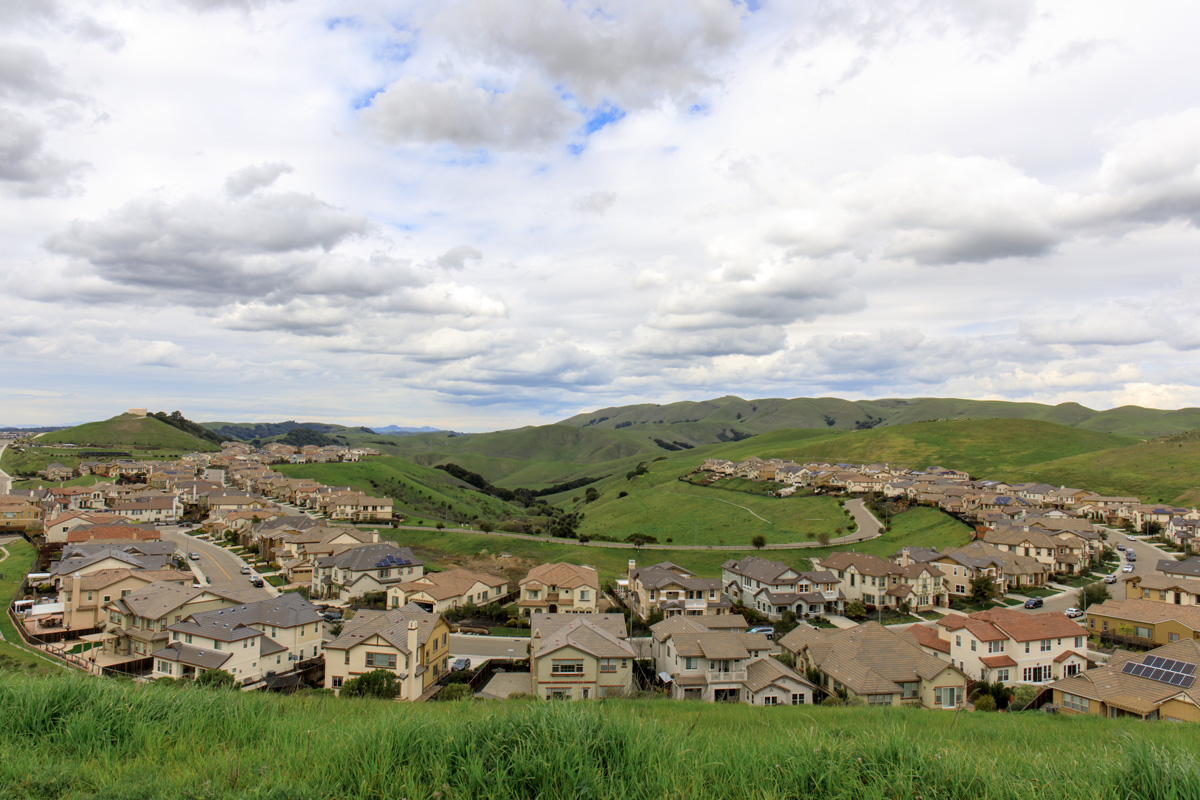
Residential homes near Dublin Hills Regional Park in northern California are built in an area designated a critical habitat for the California red-legged frog. Photo by Yuval Helfman/Adobe Stock
Wildlife populations have declined 68 percent over the past five decades, and climate change is only expected to exacerbate that trend. Yet, while studies have shown a clear link between the decline in wildlife species and human health, the principal law protecting wildlife—the Endangered Species Act—is often under fire and is expected to be weakened under a Trump administration.
A chief complaint is that the Act’s habitat protections decrease property values. However, a new collaborative study from the University of Chicago, the University of California, Berkeley, the Environmental Defense Fund, and Resources for the Future finds that across the United States, on average, that is not the case.
“Previous studies focused on specific locations where wildlife protections hurt the housing market,” said co-author Eyal Frank, an assistant professor at the University of Chicago Harris School of Public Policy. “While there are isolated cases of this, our research uncovered that these protections have, on average, had very little impact on home prices within protected areas and actually raised home values in surrounding communities.”
The authors, who include UC Berkeley professors Maximilian Auffhammer and David Sunding, examined the economic consequences of the Act after compiling the most comprehensive dataset for more than 900 U.S. species going back to the beginning of the Act in 1973. This included both species habitat designations and the more stringent critical habitat designations within and outside of protected areas. They then matched these data to the largest available dataset on housing and land transactions, as well as building permits. This allowed the researchers to more fully characterize the overall impacts of the Act as well as how different species and regions experienced different outcomes.
The researchers found that, on average across the United States, the Act’s habitat protections did not lead to fewer home sales or lower prices. In fact, home prices increased by about 10 percent on average in communities surrounding protected areas that receive a critical habitat designation. In comparison to the surrounding communities, fewer homes sold in protected areas and at a slightly lower price.
“Some have said that homes within protected areas decrease in value, but our findings point to the fact that homes have a lower price only in relation to an increasing price of homes in surrounding communities,” said Auffhammer, a professor in the Department of Agricultural and Resource Economics (ARE). “This idea that values increase for homes in close proximity to conservation lands supports the long-held belief that homeowners value open space.”
While homeowners may see value in having conservation land near where they live, the study did find some impact on the construction industry. Those building within protected areas had to go through more regulatory hoops, delaying a small fraction of permits by a few months.
“Because it becomes a little harder to build in these areas, developers might decide to build just outside the areas—leading to more homes, and perhaps with the growing scarcity of open lots, another reason for prices in surrounding communities to rise,” said co-author and Resources for the Future fellow Beia Spiller. “All in all, this seems to shift some construction activity from areas that are important for the survival of protected species toward areas that are already built up—and the shift away from protected areas means that area-based conservation policies can have their intended effect.”
The researchers caution that these results are averages across the United States. There is considerable heterogeneity in the results on a species-by-species basis. Local factors might lead to more negative impacts. For example, if there is a negative reaction to the new protections within the community, drawing more regulatory attention, this has spillover effects on home values in the area.
“Using the average impact of the Endangered Species Act from this paper when assessing the impacts of a species under consideration in a specific land market might lead to the wrong decisions being made,” said co-author David McLaughlin, a senior economist with the Environmental Defense Fund. “At the same time, the approach taken by others—investigating a specific case and applying those results to all protections everywhere—also leads to the wrong conclusions.”
The researchers’ comprehensive approach to evaluating the Endangered Species Act—looking at all species, over the lifetime of the Act, and recognizing that protected areas affect communities outside of the protections—only further emphasizes the need for a tailored approach to local decision making.
“Local leaders should have a comprehensive understanding of the species under consideration for protection, the land markets within and outside of those potentially protected areas, and other local factors at play before making a decision,” added Sunding, a professor of the graduate school in ARE. “Our study can provide the data, tools, and approach to conduct a detailed local analysis.
Read More
- The Cost of Species Protection: The Land Market Impacts of the Endangered Species Act (University of Chicago Energy Policy Institute)
- The Impact of the Endangered Species Act on Property Values (Resources for the Future)
